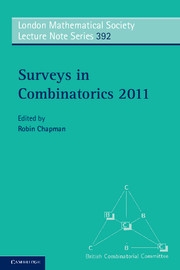Book contents
- Frontmatter
- Contents
- Preface
- 1 Counting planar maps, coloured or uncoloured
- 2 A survey of PPAD-completeness for computing Nash equilibria
- 3 Hypergraph Turán problems
- 4 Some new results in extremal graph theory
- 5 The cyclic sieving phenomenon: a survey
- 6 Order in building theory
- 7 Graphs, colours, weights and hereditary properties
- 8 Random geometric graphs
- 9 Transversals in latin squares: a survey
8 - Random geometric graphs
Published online by Cambridge University Press: 05 August 2011
- Frontmatter
- Contents
- Preface
- 1 Counting planar maps, coloured or uncoloured
- 2 A survey of PPAD-completeness for computing Nash equilibria
- 3 Hypergraph Turán problems
- 4 Some new results in extremal graph theory
- 5 The cyclic sieving phenomenon: a survey
- 6 Order in building theory
- 7 Graphs, colours, weights and hereditary properties
- 8 Random geometric graphs
- 9 Transversals in latin squares: a survey
Summary
Abstract
Suppose that we place n points in a square, uniformly at random, and form a graph by joining two if they are within some distance r of each other. What does the resulting graph look like? And how does it vary as r changes?
Alternatively, we could form a graph by placing the n points uniformly at random as before, but this time joining each point to its k nearest neighbours.
Both of these models are random but have some structure coming from the underlying planar topology. This structure gives them a very different behaviour from that of the ‘ordinary’ random graphs.
We survey the known results about these models and some other closely related models, and summarise some of the techniques used in proving such results.
Introduction
Most combinatorialists would define the start of random graph theory by the seminal papers of Erdős and Rényi ([17, 18, 19, 20]) published in 1959–61, which introduced the standard random graph model. However, roughly simultaneously (1961), Gilbert [29] introduced a different random graph model which has only recently risen to prominence. In this model the vertices have some (random) geometric layout and the edges are determined by the position of the vertices. We shall call graphs formed in this way random geometric graphs.
We want to place points uniformly throughout the plane in such a way that they occur with a positive ‘density’. This is the idea of a Poisson process.
- Type
- Chapter
- Information
- Surveys in Combinatorics 2011 , pp. 365 - 402Publisher: Cambridge University PressPrint publication year: 2011
- 10
- Cited by



